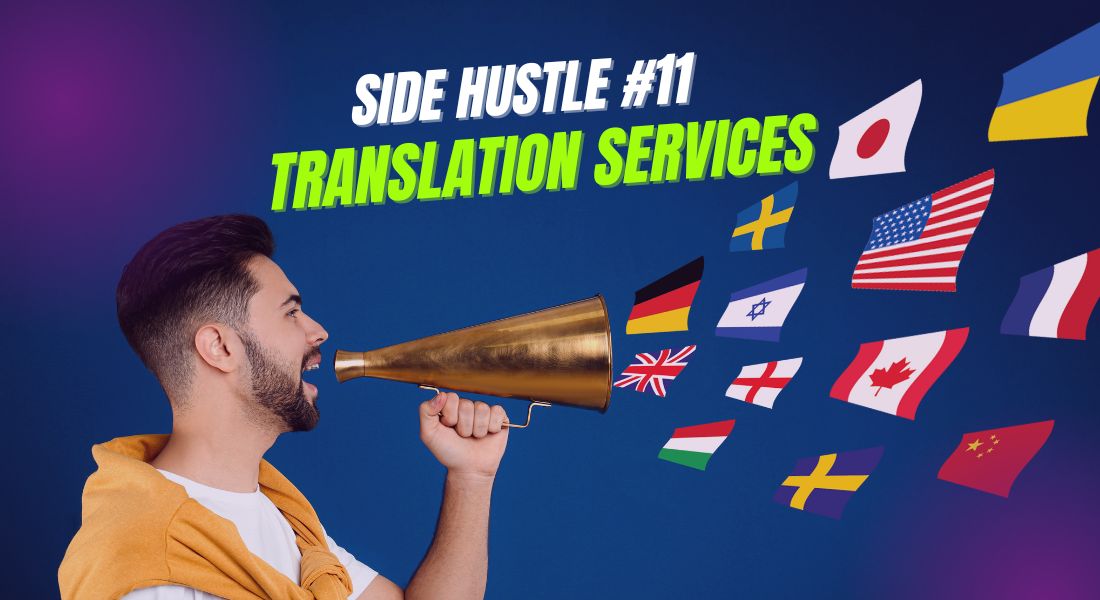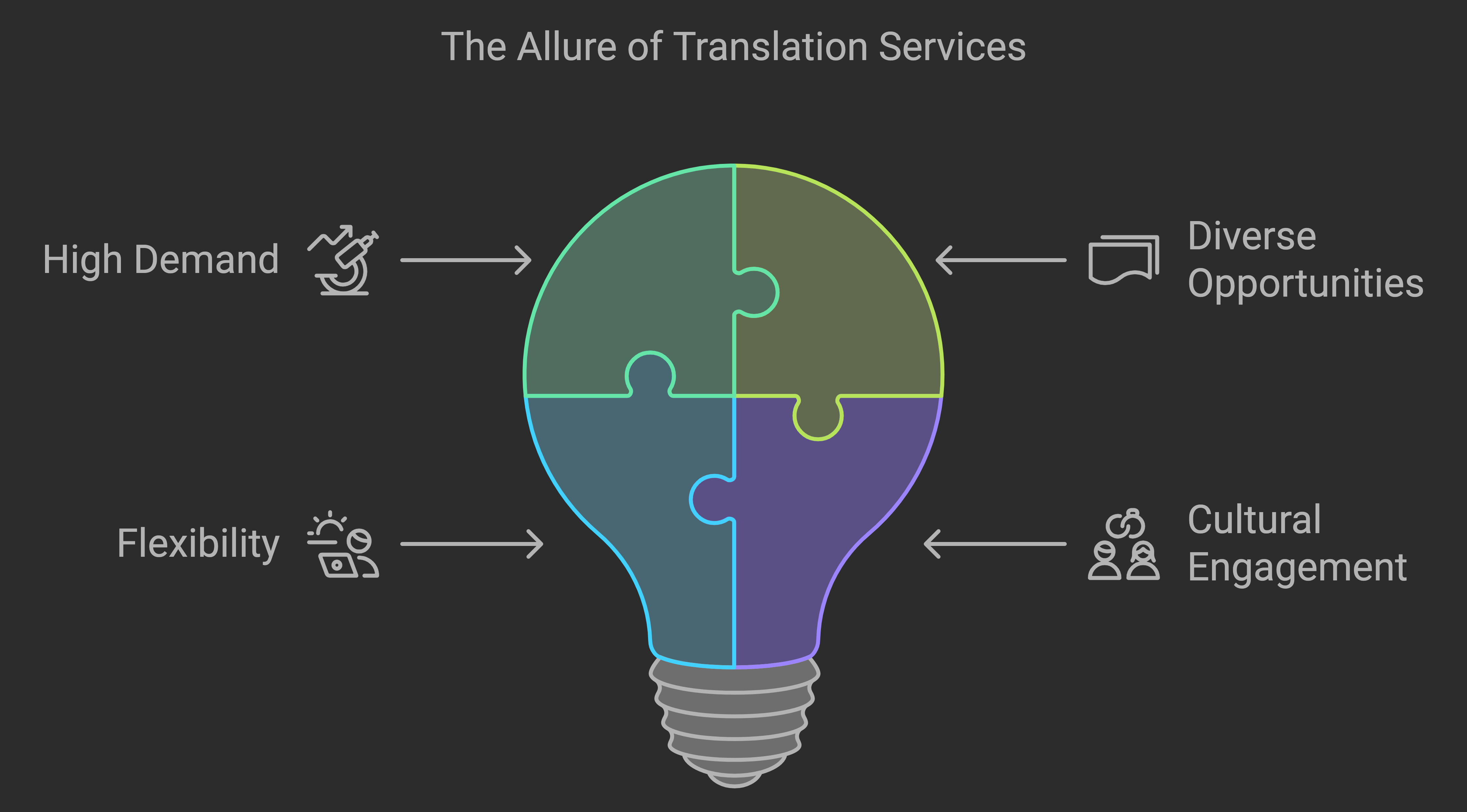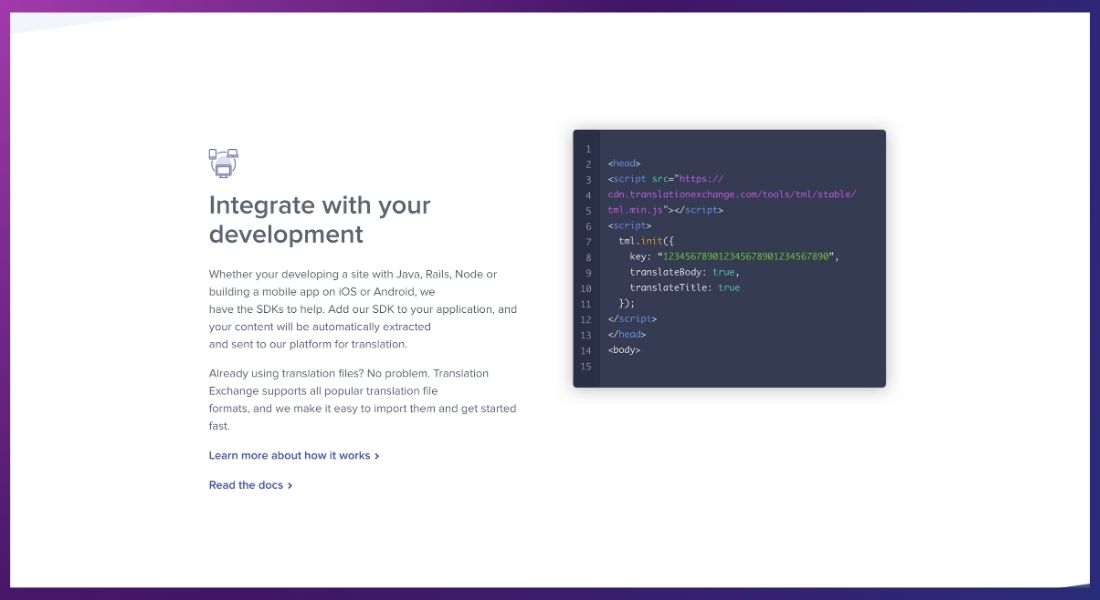👥 Side Hustle #11: Translation Services
Published on October 16, 2024 Share

In our increasingly globalized world, translation services have become essential for breaking down language barriers. Whether businesses are expanding internationally, authors are reaching new audiences, or eCommerce platforms are serving global customers, the need for skilled translators is booming. This makes translation services an ideal side hustle, offering the potential to earn between $1,000 to $4,500 per month.
Let’s dive deeper into how translation services work, who needs them, and how you can get started with this lucrative side hustle.

Why Start a Translation Services Side Hustle?
The demand for translators is rising rapidly as globalization spreads. Employment in translation and interpretation is expected to expand by 20% between 2019 and 2029, which is significantly faster than the growth rate for other occupations, according to data from the U.S. Bureau of Labor Statistics. The growing need for governments, businesses, and individuals to communicate and work together globally is driving this spike in demand for translation services.
Benefits of Offering Translation Services:
- High Demand: Every business aiming to reach global markets needs translations for websites, contracts, marketing materials, and more.
- Diverse Opportunities: You can work with a range of documents, from legal contracts and books to technical manuals and academic journals.
- Flexibility: As a translator, you can work remotely, making this an ideal side hustle to fit around your existing schedule.
- Cultural Engagement: You’ll have the unique opportunity to engage with various cultures, making your work not just financially rewarding but also intellectually stimulating.
Translation services are vital for making information accessible in multiple languages. Whether it’s for businesses or individuals, your skills will always be in demand.
Who Needs Translation Services?
The beauty of translation services is that they're universally needed across many industries. Let’s take a look at who typically requires your expertise:
1. Businesses Expanding Internationally
Businesses require their content, including websites, legal papers, and marketing materials, translated to reach local audiences as they grow into new markets. This guarantees that their message is factual and culturally relevant.
Example: A fashion brand looking to enter the European market hired a translator to localize its product descriptions and marketing campaigns. Thanks to well-crafted translations, the brand saw a 30% increase in international sales within three months.
2. eCommerce Businesses
With online shopping booming, eCommerce companies must provide localized product descriptions, customer service replies, and user manuals to ensure smooth global operations.
Pro Tip: When working with eCommerce businesses, focus on quick, accurate translations to help them launch products in new markets faster and more effectively.
3. Authors and Publishers
Authors and publishers frequently need translations for books, academic journals, and articles to expand their readership globally. Translating literary works can also require creativity to maintain the author's voice and message.
4. Educational Institutions
Translations are frequently needed for course materials, applications, and other official papers at universities and institutions that accept overseas students. This can be a reliable source of work, especially during the admissions process.
5. Government Agencies
Government departments and agencies need translation services for legal documents, diplomatic communications, and international relations. Accurate and precise translation is especially critical in this context.
How to Generate Leads for Translation Services
To build a successful translation services business, you need to generate leads consistently. Here’s how to do it:
1. Build a Professional Website
Your website is your online portfolio. Showcase your language skills, the types of documents you specialize in, and client testimonials. Include samples of your previous work to demonstrate your translation expertise.
Pro Tip: Specialize in a niche, such as legal, medical, or technical translations, to stand out from the competition and attract more clients.
2. Join Translation Platforms
Sign up for freelancing and translation platforms like ProZ, Gengo, or TranslatorsCafe to connect with clients looking for translators. These platforms can help you get consistent work, especially when starting.
3. Networking
Attend language-related events, conferences, and seminars to connect with potential clients and other professionals in the field. Networking is not only an excellent way to get leads but also to stay informed about trends in the translation industry.
4. Promote on Social Media
Platforms like LinkedIn, Facebook, and Twitter can help you reach more potential clients. Share your translation projects, offer language tips, and engage with followers to build a professional network.
5. Cold Outreach
Identify businesses, authors, and publishers who might need your services and send them personalized emails highlighting how your translations can benefit their business.
Pro Tip: Offer a discounted trial for your translation services to attract new clients and give them a glimpse of your work quality.
How to Fulfill Translation Services
Maintaining the original intent, tone, and context is more important than just translating words between languages when providing professional translation services. Let’s go step-by-step through the process, using a real-world example to illustrate each stage of service fulfillment.
Step 1: Understand the Document
The first step is to fully understand the document you're translating. This involves analyzing the content, context, and the client’s goals.
Case Study: A tech startup approached a translator to localize their user manual for a new software release. The manual needed to be translated from English into Spanish for their Latin American market. The translator began by discussing the company’s objectives, identifying the target audience's needs, and reviewing the technical terminology to ensure accuracy.
Step 2: Translate the Document
Once the translator understood the document’s purpose, they began translating the text. Accuracy was key, but so was maintaining the original tone and technical language.
Case Study: The translator carefully worked through the technical manual, ensuring that complex software features were explained in clear, user-friendly terms. While translating, the translator made sure that the technical jargon used in English was localized to match common terminology used by Spanish-speaking developers and users.
Step 3: Proofread and Edit
After translating, it’s essential to proofread the document for grammatical errors, mistranslations, and overall flow. This ensures clarity and accuracy.
Case Study: After completing the translation, the translator went through the entire document again, fixing minor errors and adjusting the sentence structure to make it flow naturally in Spanish. They used translation tools like MemoQ to manage terminology and maintain consistency throughout the document.
Step 4: Client Review and Feedback
Once the initial draft is complete, send the document to the client for review. Incorporating their feedback ensures the final translation aligns with their expectations.
Case Study: The startup reviewed the translated user manual and requested a few tweaks, particularly around the phrasing of technical instructions. In close collaboration with the client, the translator made the required changes to guarantee that the handbook was accurate and simple enough for the intended audience to understand.
Step 5: Final Review and Delivery
Make one final check before sending the finished product to make sure all suggestions have been taken into account and the translation satisfies the highest requirements for quality.
Case Study: After making the revisions, the translator did a final check of the entire user manual, ensuring that all edits had been addressed. They delivered the completed translation, ready for use in the company's product launch, and received positive feedback on the clarity and accuracy of the work.
By following these steps, you can ensure that your translation services are accurate, professional, and tailored to the client’s needs. Similar to the tech startup, happy clients and recurring business can be achieved by comprehending the purpose of the document and the objectives of the client, communicating clearly, and providing high-quality translations.
Best AI Tools for Translation Services
Incorporating AI tools into your translation services can enormously enhance both the speed and accuracy of your work. While human expertise is irreplaceable, these tools help streamline tasks, manage large projects, and ensure consistency across translations. Here are some top AI tools you can use:
1. Google Translate
- Key Feature: Google Translate offers fast translations for over 100 languages and is a great tool for quick reference or understanding the general meaning of the text. It’s best used for basic translations but can struggle with highly technical or context-specific content.
- Advanced Use: Although it is not ideal for high-level professional translation, you may incorporate Google Translate's API into your app or website to give consumers automated translations.
- Free Version: Available for all users. It also has a mobile app, which makes it handy for on-the-go translations.
2. DeepL
- Key Feature: Known for producing more contextually accurate translations, DeepL uses AI and neural networks to deliver better translations than many alternatives, especially for European languages. It’s often regarded for its ability to understand nuances and cultural contexts, which is crucial for professional translations.
- Advanced Use: DeepL also allows you to customize translations by offering various suggestions for words or phrases, making it ideal for more detailed, context-sensitive work.
- Free Version: Available with limited features; a premium version offers higher volumes and additional language pairs.

3. SDL Trados Studio
- Key Feature: SDL Trados Studio is an industry-standard professional translation software offering translation memory, which stores previously translated content for future use. This helps improve consistency across projects, particularly when dealing with recurring terminology.
- Advanced Use: SDL Trados is perfect for large projects involving technical, legal, or medical documents, where consistent use of terminology is vital. It also integrates with various plugins and translation management tools to streamline your workflow.
- Free Trial: Available for 30 days.
4. MemoQ
- Key Feature: MemoQ is a translation management software that enables collaboration among translators, improves efficiency, and provides real-time project tracking. Its terminology management and translation memory features ensure consistency, especially in highly specialized fields like legal or medical translations.
- Advanced Use: MemoQ is a great choice for teams because it enables translators to collaborate on projects. In addiction, it supports a wide range of file types, making it possible to integrate with clients' document systems with ease.
- Free Trial: Available for 30 days, after which you can opt for premium features.
5. Mate Translate
- Key Feature: Mate Translate is a browser extension that offers quick, in-browser translations. It’s ideal for translating web pages, emails, or any text-based content you encounter during research.
- Advanced Use: Mate Translate supports synonym suggestions and phrase translations, which can help you better understand contextual meanings. It also allows you to save translations for future reference, making it easier to work on ongoing projects.
- Free Version: Available with basic features, including instant translations.
6. Translation Exchange
- Key Feature: Translation Exchange helps manage multilingual content for websites and apps. It provides real-time translations and allows users to integrate localization workflows into their platforms, making it particularly useful for tech-based translation services.
- Advanced Use: Its collaborative features allow multiple translators to work on a project simultaneously, tracking progress and updates in real-time. It’s especially helpful for teams working on dynamic websites or mobile applications with continuous updates.
- Free Trial: Available, with premium versions offering advanced management features.

7. Smartling
- Key Feature: Smartling is a cloud-based translation management tool that focuses on website localization, helping businesses scale their content for global audiences. It automates much of the repetitive work involved in translating web content, including continuous updates to dynamic sites.
- Advanced Use: Smartling’s visual context editor allows you to see the translated content as it will appear on the webpage, helping you ensure accuracy in real-time. It's particularly useful for large-scale projects, where ongoing updates and multiple contributors are involved.
- Free Trial: Available, with paid plans for advanced features.
Conclusion: Leverage AI for Better Results
Using AI-powered tools in your translation workflow can help improve accuracy, manage terminology, and ensure consistent quality across projects. While these tools won’t replace the need for human translation, they can complement your skills, allowing you to handle more projects and meet tight deadlines. Whether you're working on technical documents or website localization, combining AI tools like DeepL for nuanced translations and SDL Trados for managing large-scale projects will give you a competitive edge in the translation industry.
Final Thoughs
Translation services offer a rewarding and flexible side hustle, with the potential to earn between $1,000 to $4,500 per month. You can establish a thriving translation business by honing your language skills, leveraging AI tools, and building your online presence.
Looking for more ways to grow your income? Check out our guide on Data Analysis and explore how this skill can help you succeed in the digital world.







